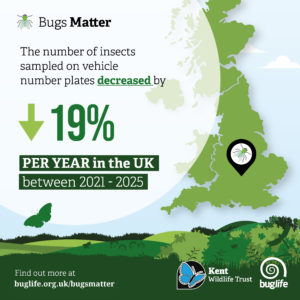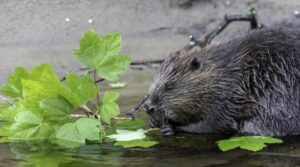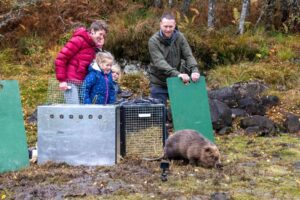The troubling extent of insect declines has been highlighted once again by the results of the 2025 Bugs Matter citizen science survey published today.

The latest data show that the number of flying insects sampled on vehicle number plates across the UK has fallen by a staggering 59% in just 5 years.
Bugs Matter, the annual survey from Buglife and Kent Wildlife Trust, has captured the imagination of citizen scientists across the UK and the Republic of Ireland. Using the simple but ingenious method of monitoring insect splats on vehicle number plates, the project provides crucial data about insect abundance. Analysis of records from more than 25,000 journeys shows an alarming annual average decline in bug splats of 19%, since the survey began in 2021.
As COP30, the 30th UN climate conference, draws to a close in Brazil this week, world leaders have been discussing priority actions to tackle climate change, one of the key drivers of insect decline. Insects are critical to ecosystem functioning and services. They pollinate crops, provide natural pest control, decompose waste and recycle nutrients, and underpin food chains that support birds, mammals and other wildlife. Without insects, the planet’s ecological systems would collapse.
Andrew Whitehouse of Buglife said: “You might expect that the sunny Spring and hot Summer in 2025 would give insect numbers a boost, however the Bugs Matter data suggest otherwise. Despite apparently favourable conditions for insects to thrive we have recorded a fifth year of significant decline. Insects might be small, but they are incredibly important to maintaining healthy environments, and delivering the services that we and other animals rely upon – from healthy soils and clean rivers to pollinating crops. Losing 59% of our insect life is potentially catastrophic. Urgent action is needed to restore nature at scale and reduce threats like pesticide use, habitat loss, and climate change.”
The new data show decreases in insect splats across all regions of the UK, with the sharpest falls between 2021 and 2025 recorded in England at 60% and Scotland at 59%, while a 56% decrease was shown in Northern Ireland and a 55% decrease was seen in Wales. In 2025 the survey ran in the Republic of Ireland for the first time so there is no trend data, but the splat rates are comparable with other areas surveyed and provide a baseline for subsequent survey years in the Republic of Ireland.
Rosie Bleet of Kent Wildlife Trust added: “These results are extremely concerning, particularly if insect splats serve as an accurate measure of insect populations. This is a red flag for the state of nature in the UK that shouldn’t be ignored. A yearly decrease of 19% is really alarming. It is vital that we continue to run Bugs Matter next year and beyond. We’re so grateful to all of the citizen scientists who were involved in the survey this year, collecting more data than any other year. We need even more of you to get stuck in next year and help track the numbers of these important creatures.”
Citizen scientists logged more than 10,000 journeys in the Bugs Matter app in 2025, covering nearly 481,000km; with more than 700 new users signing up to the app. We also saw citizen scientists recording journeys in the Shetland Islands for the first time; meaning Bugs Matter participants surveyed as far southwest as Land’s End up to John O’Groats and beyond! We thank everyone who has taken part this year and helped to collect this vitally important data and encourage even more people to take part in 2026.
Beavers released into Highlands in a moment of ‘wildlife history’

Beaver eating Sycamore. Photo: NatureScot
Beavers have been released into a Highland glen, marking a moment of “wildlife history” for the species. It comes after NatureScot granted a licence in August for the release of four family groups of beavers to the waters above Beinn a Mheadhoin dam in the Glen Affric national nature reserve (NNR) in the north-west Highlands. The first two releases, of a beaver pair and then a family of five, took place on October 24.

First Beaver release in Glen Affric. Photo: Beaver Trust
Beavers were driven to extinction in Scotland some 400 years ago but an initial reintroduction trial of beavers at Knapdale in Argyll began in 2009 and they have since been released elsewhere. The release in Glen Affric follows three phases of extensive consultations with local communities and land managers.
Forestry and Land Scotland (FLS), which manages the 17,604-hectare NNR, has been working in partnership with Trees for Life on the initiative since 2022, supported by Beaver Trust.
Steve Micklewright, Trees for Life’s chief executive, said: “As we saw the beavers released into the loch, we were watching a moment of wildlife history – offering hope for tackling the nature and climate emergencies, and a better future for biodiversity and people.
“We’re proud to have worked with FLS on this community-focused initiative. They have undertaken vital habitat restoration work in Glen Affric over many years and shown real leadership in nature restoration by reintroducing this important habitat-creating, biodiversity-boosting, flood-preventing animal.”
The Scottish Government announced in 2016 that beavers would be allowed to remain in Scotland and in 2019 they were recognised as a protected species. Before being released in Glen Affric, the beavers were housed at a specialised beaver holding and quarantine facility at Five Sisters Zoo for health checks.
FLS north region manager Alex Mcleod said: “Beavers being translocated to Glen Affric is the culmination of a long, exacting and thorough process for FLS and Trees for Life.
“Fully engaging with the local Affric communities, including through a detailed consultation process, has been crucial in making sure that all voices were heard.
“This high degree of local consultation has helped put in place processes to discuss any necessary mitigation and to address concerns raised by those not in favour of beaver introductions.
“We are establishing a group to oversee ongoing monitoring to inform management decisions in the months and years to come, and I would hope that the beavers eventually become an integral and unremarked part of Glen Affric.”
Experts said that beavers create wetlands that benefit other wildlife, purify water and reduce flooding. While the animals can sometimes create localised problems, the Glen Affric project partners said they have put measures in place to address these quickly should they emerge.
Pine Martens are reintroduced in Somerset

Pine Martens return to Exmoor after over a century
The Two Moors Pine Marten Project released nine females and 10 males at secret locations on Exmoor in September.
Despite concerns from the public, Simon Clarke, head of nature recovery for Somerset Wildlife Trust wants to reassure people the reintroduction of the animal will restore balance in local woodlands and says there is “plenty of habitat to accommodate the species”.
Mr Clarke said the project was “about restoring balance to our woodland ecosystem”, which pine martens were a critical part of before their woodland habitat was lost and they were hunted for fur.
He said the animals feed on fruit, especially in the autumn, which helped the surrounding environment.
“So they’ll be spreading the seeds and there will be new plants growing. They are an important part of our woodland flora,” he explained.
Pine martens are predators and eat fruit but they also feed on small mammals like mice and voles. Mr Clarke said other mammals had adapted to their presence over the years.
“Red squirrels for example are adapted to pine martens, they’re smaller, lighter and faster,” he said.
“Whereas grey squirrels aren’t adapted to them – so actually it could be beneficial to red squirrels,” he added.
Read the latest newsletter from the Seahorse Trust >>
Seahorse Trust Autumn-Winter 2025 newsletter
The results of Butterfly Conservation’s Big Butterfly Count are in, and while the numbers are a vast improvement on 2024’s record lows, experts warn urgent measures are still needed to reverse long-term decline.
The sunniest spring and hottest summer ever recorded in the UK provided good weather conditions for butterflies after 2024’s record-breaking lows. However, the results from the Big Butterfly Count show that it was definitely not a bumper summer for our beleaguered butterflies.
Between July 18 and August 10, over 125,000 citizen scientists got involved in the Big Butterfly Count – more than ever before – and recorded 1.7 million butterflies and moths, with the top five species being Large White, Small White, Gatekeeper, Red Admiral and Meadow Brown.
On average, participants recorded 10.3 butterflies during each 15-minute count. While a marked improvement on last summer’s record low of just 7.2, it is only broadly average by modern standards, and has done little to reverse longer-term declines.
Butterflies need two things to thrive: good weather and a healthy environment.
Dr Richard Fox, Head of Science at Butterfly Conservation, warns that “We may feel like we’ve seen lots of butterflies this summer, but that’s only because last year was so awful.
“Last summer’s results were the lowest we’ve seen and a stark warning that many of our common butterfly species are facing significant pressure from challenges linked to habitat loss, climate change and pesticide use.
“Whilst we’ve seen noticeably more butterflies during 2025’s Big Butterfly Count, the figures suggest it’s actually been a pretty average year for them by modern standards.
“The 15-year Big Butterfly Count trends show that more than twice as many widespread species have declined significantly than have increased. And, while most species had a better than average summer, one-third of species fared poorly even in the generally beneficial weather.
“There remains a need for us to take urgent action to support our butterfly populations, including by improving the environment in which they live, restoring habitats and reducing pesticide use. Until we do these things we are unlikely to see a great recovery in butterfly numbers, regardless of how much the sun shines.”
Winners and losers
Some species did show marked increases this summer. The Large White and Small White both recorded their best ever Big Butterfly Count result. View the results for each species below by selecting each tab along the top of the below graph:
Butterfly abundance 2016-2025 by Butterfly Conservation
Meanwhile the Small Tortoiseshell, which had its worst Big Butterfly Count result on record in 2024, showed some improvement but still recorded a below average year and has declined by 60% since 2011.
The Jersey Tiger moth had a record year. The species was recorded more widely and in higher numbers than ever before.
By contrast, Holly Blue had its second worst Big Butterfly Count result on record, Common Blue had its third worst and Meadow Brown had its fourth worst Count result.
| Big Butterfly Count 2025 UK | Abundance | Average per count | % change from 2024 | 14-year trend (bold significant) |
| Large White | 396,510 | 2.449 | 131.42 | 46.74 |
| Small White | 318,762 | 1.969 | 128.27 | 7.49 |
| Gatekeeper | 236,425 | 1.460 | 0.31 | -21.87 |
| Red Admiral | 166,289 | 1.027 | 185.17 | 51.54 |
| Meadow Brown | 133,025 | 0.822 | -39.57 | -18.02 |
| Peacock | 96,155 | 0.594 | 52.78 | -12.24 |
| Speckled Wood | 53,423 | 0.330 | 43.33 | -35.14 |
| Comma | 43,062 | 0.266 | 42.01 | -1.13 |
| Common Blue | 39,602 | 0.245 | 227.97 | -54.30 |
| Green-veined White | 39,272 | 0.243 | 67.42 | -57.40 |
| Small Tortoiseshell | 37,186 | 0.230 | 141.65 | -59.68 |
| Small Copper | 20,925 | 0.129 | 21.08 | 93.89 |
| Holly Blue | 20,685 | 0.128 | 135.70 | 10.19 |
| Ringlet | 18,386 | 0.114 | -66.45 | -42.51 |
| Painted Lady | 15,856 | 0.098 | 207.19 | 14.24 |
| Jersey Tiger | 11,876 | 0.073 | 174.44 | |
| Brimstone | 9149 | 0.057 | -14.27 | -6.60 |
| Six spot burnet | 5943 | 0.037 | -73.48 | |
| Marbled White | 2125 | 0.013 | -90.42 | -17.49 |
| Silver y | 1940 | 0.012 | -61.78 | |
| Scotch Argus | 1376 | 0.008 | 122.78 | |
| TOTAL | 1,667,972 | 0.49 | 63.59 |




